Here’s something you might have seen before: Twickenham Chess Club’s 1896 victory over Metropolitan.
Regular readers will have met several of these players already, but not Twickenham’s Board 6: E B Schwann.
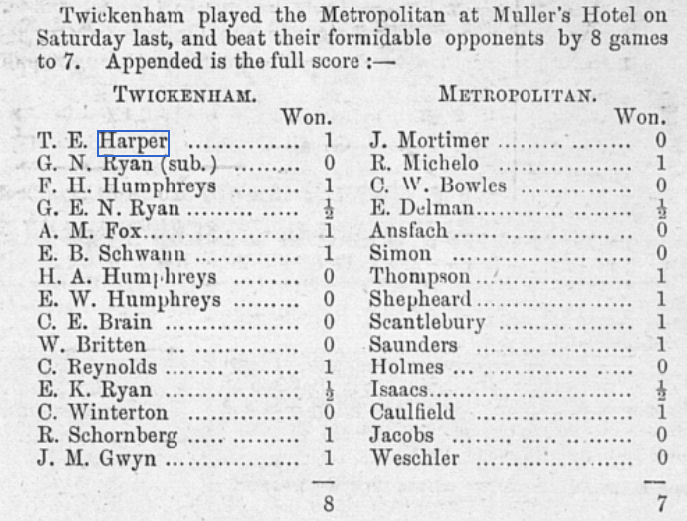
Edward Bagehot Schwann was born in Hampstead in 1872, probably towards the end of September. Edward came from a privileged background. His father, Frederick Sigismund Schwann, himself the son of a German born merchant, had been born in Huddersfield, famed in Hampshire for a while before moving to London and working as a Commission Merchant. His mother, Mary Watson Halton Bagehot, was a first cousin of Walter Bagehot, best remembered as the author of The British Constitution.
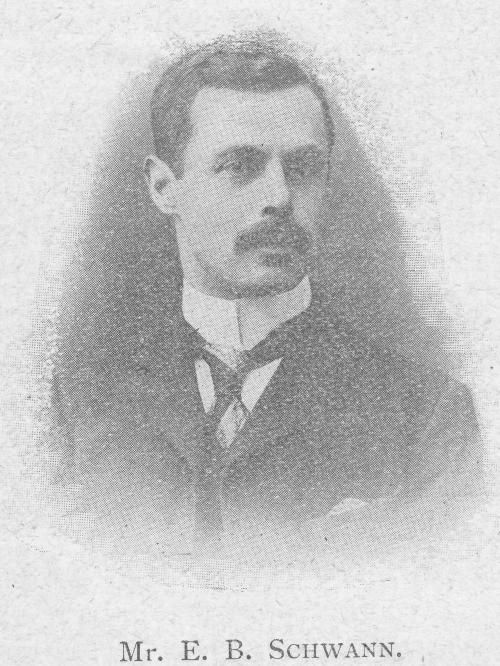
The 1881 census found Frederick and Mary living in West Heath Lodge, Branch Hall Park, Hampstead, with five children, two cousins, a governess and six servants.
Young Edward was educated at Bromsgrove School where he excelled at cricket. A brother, Henry Sigismund, would go on to represent Oxford University at cricket. An uncle, Charles Ernest Schwann, was a prominent Liberal politician, noted for his radical views, and MP for Manchester North between 1886 and 1918.
Edward must have excelled at chess as well as cricket at school, as he first came to the attention of the chess world in 1886 as a problem solver. Perhaps solving chess problems was popular with the cool kids back in the day.
It wasn’t long before Edward started composing problems himself: direct mates mostly in 2 or 3 moves. Here’s an early example.
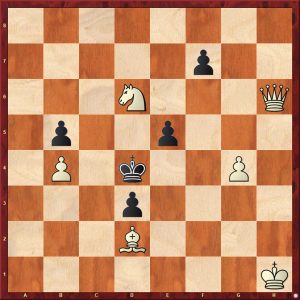
A typical problem by a novice composer of the day, I’d say, but he would soon add more complexity to his compositions. (You’ll find the solutions to the problems at the end of the article.)
In 1890 Edward completed his education at Bromsgrove School, achieving a Higher Certificate in Latin, Elementary and Additional Mathematics, English and History, and, rather than proceeding to Oxford or Cambridge, returned home to his family in London.
By this point they’d moved from Hampstead to Wimbledon, living in Park House, Inner Park Road. The house itself no longer exists, but it was just off the A219 across the road from Putney Heath. The 1891 census records Frederick and Mary along with six of their children, including Edward, described as a Scholar (perhaps he was at London University) and no less than eight servants. They were clearly living in some style.
By the following year, Edward had joined the City of London Chess Club. The first mention of him I can find is from July 1892, where, described as ‘the rising young problem composer’, he won a game in a simul given by the strong amateur Percy Howell.
In January 1893 he had a game from the City of London Club Championship published in the Morning Post, although it must be admitted that White’s opening play was pretty feeble and that his queen sacrifice, while attractive, was not the only way to win. As a problemist, though, he might have had no choice. (You can click on any move in any game in this article and a pop-up window will appear enabling you to play it through.)
By 1893 he was playing in matches for his club: here he is in a match against Oxford University. (I suspect A F Fox is a typo for A M Fox.)
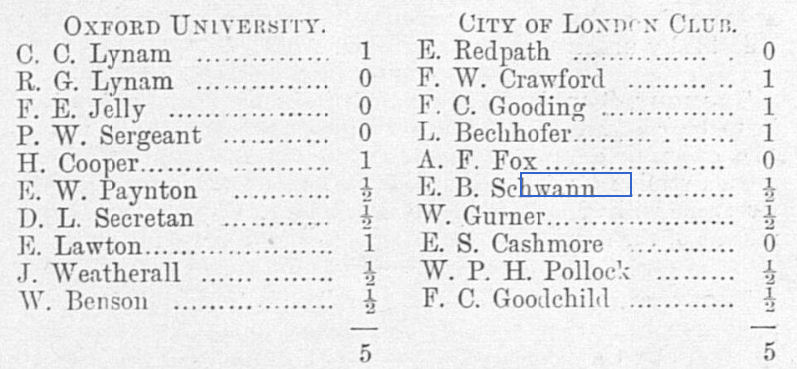
In October that year Blackburne visited the City of London Club to play an 8-board blindfold simul: the only winner was ‘a rising talented player and problem composer’ – E B Schwann. (One of the three players who drew was recorded as Dr J K Leeson: this may have been a typo for Dr J R Leeson, who will feature in a future Minor Piece.) By now Edward was playing for the Metropolitan club as well as City of London.
In 1894 he represented the winning team, Surrey, in the final of the inter-county championship against Gloucestershire – but his affiliation is given as S.C.A. (Surrey Chess Association), suggesting he wasn’t, at that point, a member of any Surrey club.
In October 1894 a 50 board match took place between the Metropolitan and City of London clubs. Edward played as a reserve for City of London, finding himself faced with W H Gunston, a player of genuine master strength.
The newspaper report rather unhelpfully reported the match in alphabetical order of the Metropolitan players rather than in board order.
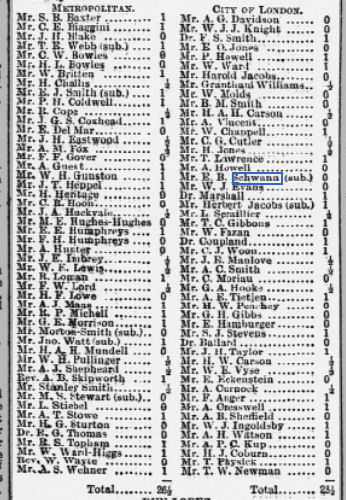
Meanwhile Edward’s problem career was continuing to grow: this problem was a first prize winner.
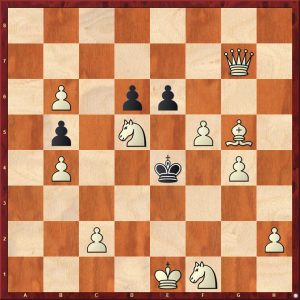
He seemed to be present in almost every club or county match going, as well as composing prolifically. He was particularly successful over the board in the 1895-6 season: maybe one of his friends, Arthur Makinson Fox, perhaps, suggested that he might be prepared to make the journey from Wimbledon to Twickenham to join the local club, with the result that you saw at the top of this article.
In 1897 Frederick Richard Gittins published his book The Chess Bouquet. Here’s what he had to say about Edward Bagehot Schwann.
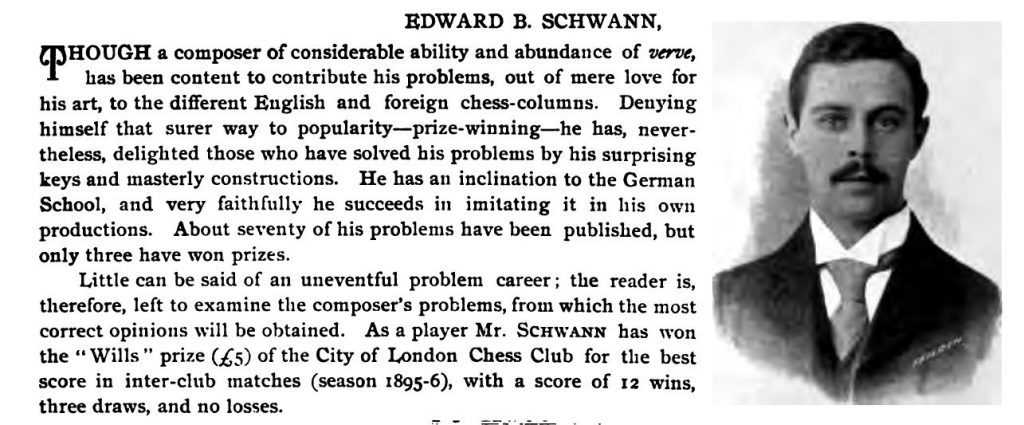
His improved form had come to the notice of the selectors and, in a match against Cambridge University, he found himself on board 2, where he lost to a most interesting opponent, E A Crowley.
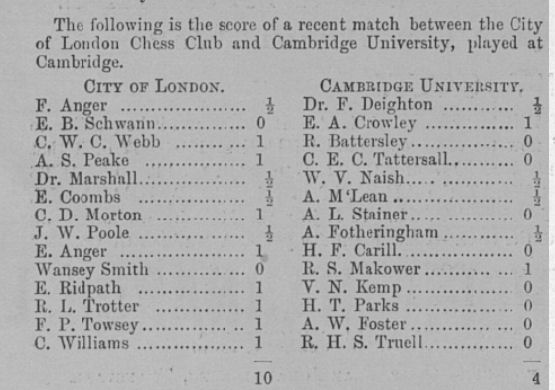
Yes, this was Edward Alexander, better known as Aleister Crowley, star of The (Even More) Complete Chess Addict. You can read more about his chess career here.
Soon after this match, Edward disappeared from the London chess scene, spending a year in Munich learning more about the German School of chess composition from the experts there, and also visiting Prague, where he played this game.

Here’s another prizewinning mate in 3. Was it influenced by his time in Germany?
By the time he returned in early 1898 Twickenham Chess Club had transitioned into Thames Valley Chess Club, and, while rejoining his now Teddington based colleagues he also decided to join the new Richmond Chess Club, which was, as we’ll see in future articles, becoming more ambitious.
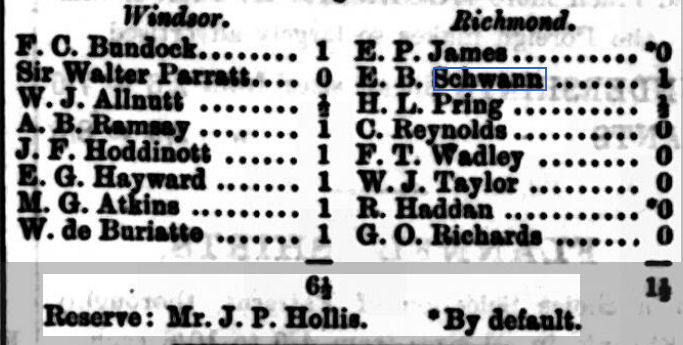
Here he is, in late 1899, in one of Richmond’s regular matches against Windsor, where he met another famous opponent who could hardly have been further removed from Crowley: Sir Walter Parratt.
In this game from a county match in January 1900, he preferred 9… g6 to the more popular 9… Qd5 in the famous Max Lange Attack. Today’s engines agree with him, preferring Black after this move.
From the same period, here’s a loss against tinned milk pioneer Arthur James Maas from the Surrey Challenge Cup. The game seemed to feature a lot of rather inconsequential manoeuvring typical of those days of limited positional understanding before Black came out on top.
In September 1900 Edward decided the time had come to take part in a tournament against stronger oppostion. He entered the top section of the Southern Counties Chess Union championship in Bath, but found the event tough going, eventually finishing in 12th place on 3½/14. The great Henry Ernest Atkins was the winner on 12½/14, a point ahead of Herbert Levi Jacobs. Although a decent county standard player, he was no match for those of master strength. Undaunted, he entered the City of London Championship, but was again unsuccessful.
The 1901 census recorded Edward as still living with his parents, three sisters and eight servants in Wimbledon, and working as a Publisher’s Clerk. By now he was very much respected not just as a composer of problems, but as a leading authority called upon to act as a judge in composing competitions.
He was also continuing to play in club and county matches: clearly a true chess addict, and, given that he was still in his 20s, there was every chance that he would add to his reputation over the next few decades.
He had also, at round about this time, fallen in love, and would soon announce his engagement to Miss Rita Fox (apparently no relation to A M Fox) of the Ladies’ Chess Club (also here and here) a lady of rather mysterious origins. I hope to write a series of articles about some of the Ladies’ Chess Club members when time permits.
But then, on 7 September 1902, at the age of only 30, his life came to a very premature end when he died suddenly of heart failure.
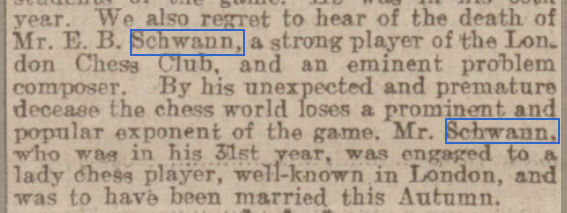
He had made a will a couple of months earlier so perhaps he knew he was ill. The value of his estate was £20370, about £2.67 million today, and he ensured his fiancée was well provided for. He also left a bequest to the celebrated master Richard Teichmann, who was struggling with both financial and health matters, and was, as a result, able to afford an operation. I haven’t yet been able to identify Russell Scott junior: can anyone help?

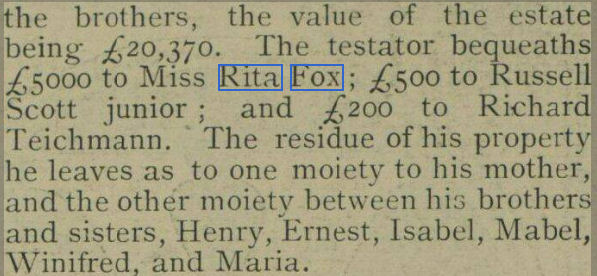
There are some more stories to be told. Due to the prevalence of anti-German sentiments during the 1910s, many possessors of German surnames chose to change them. Several members of the Schwann family simply dropped the ‘ch’, becoming Swann. Edward’s brother Ernest, however, preferred to use his mother’s maiden name: Bagehot. Ernest married Ethel Caroline Pollock, whose mother, Amy Menella Dodgson, was a first cousin of Charles Lutwidge Dodgson, better known today as Lewis Carroll. Carroll was himself a keen chess player and used the game in Through the Looking Glass. Ethel’s second cousin once removed, Algernon Pollock Aris, married Janet Alicia Elford, my third cousin once removed (here‘s their oldest son). So, if my tree is correct, Edward Bagehot Schwann, one of the first members of Richmond Chess Club, is the brother-in-law of the 2nd cousin 1x removed of the husband of my 3rd cousin 1x removed!
Another coincidence: some years ago I taught a boy named Adam Swann, whose parents were, and still are, family friends. His 7-year-old son is now an enthusiastic player. His name, of course, is Edward Swann.
Perhaps he’ll follow in the footsteps of his near namesake, a true chess enthusiast who, in his tragically short life, became a pretty useful player, and, more importantly, a leading authority on and composer of chess problems.
Come back soon for more stories of the early members of Richmond Chess Club.
Acknowledgements and sources:
ancestry.co.uk
findmypast.co.uk
edochess.ca
chessgames.com
chess.com
BritBase
Yet Another Chess Problem Database
Wikipedia
The Chess Bouquet (thanks to Tim Harding)
Various other online resources linked in the text
Solutions:
Problem 1:
1. Qf6! Kd5 2. Nf5! Ke4 (2… e4 3. Ne3#) (2… Kc4 3. Qxf7#) 3. Qc6#
Problem 2:
1. Qb7!
1… Ke5 2. Bf6+ ♔e4 3. Nd2#
1… Kd4 2. Nd2 2… Ke5 3. Bf6# 2… e5 3. Be3# 2… e×d5 3. Qg7# 2… e×f5 3. Bf6#
1… Kf3 2. Ne3+ d5 3. Nd2#
1…e5 2. Nd2+ Kd4 3. Be3#
1… e×d5 2. Nd2+ 2… Kd4 3. Qg7# 2… Ke5 3. Qg7# 1… e×f5 2. Ne3+ 2… Kd4 3. Bf6# 2… Ke5 3. Qd5# 2… d5 3. Q×d5#
Problem 3:
1. Nc3! threat 2. Qd5+ 2… Kf4 3. Bh6# 2… Kf6 3. Ng4# 1… Be4 2. Q×e4+ Kf6 3. Qf5# 3. Qe7# 3. Qf4#
1… Ba2 2. Qe4+ Kf6 3. Qf5#/3. Qe7#/3. Qf4#
1… N×f2 2. Qg7+ Kf4 3. Qg3#
1… Kd4 2. Ne2+ 2… Ke3 3. Bh6# 2… Ke5 3. Ng4# 2… Kc4 3. Qg8#
1… Kf4 2. Ne2+ 2… Ke3 3. Bh6# 2… Ke5 3. Ng4#


One thought on “Minor Pieces 31: Edward Bagehot Schwann”